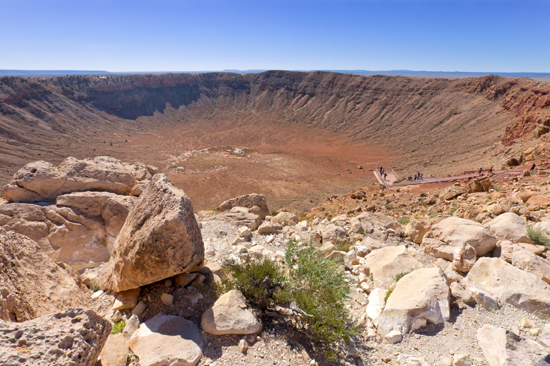
In Phil Plait’s talk from TEDxBoulder, “How to defend earth from asteroids,” he astonishes the audience, sharing how a single rock hurtling through space could damage our civilization as we know it.
This weekend, TED Weekends on the Huffington Post features Plait’s spine-tingling talk. Below, some of our favorite essays from this edition, about those big mysterious rocks that might be barreling right for us.
Phil Plait: How to Defend Earth From Asteroids
The Earth sits in a cosmic shooting gallery.
Millions of asteroids orbit the Sun, some on paths that cross that of Earth. These range in size from grains of sand — which create beautiful but harmless shooting stars when they burn up in our atmosphere — to rocks the size of football stadia and even cities themselves. One such asteroid, 10 kilometers across, impacted the Earth 65 million years ago, and the resulting devastation wiped out the dinosaurs essentially overnight.
We know there are no rocks that big headed our way anytime soon, at least not for centuries. But it only takes one asteroid, 100 or so meters across, impacting the Earth to explode with the force of a dozen nuclear weapons. This is something we might wish to avoid!
So what do we do?
Buying insurance is seldom gratifying. But here’s a case in which plunking down cash for a policy is just … good policy.
The threat is familiar: rocks from the sky, known as asteroids — the subject of a 2011 TEDx talk by astronomer Phil Plait. These leftovers from the birth of the Sun and planets race around at thirty thousand miles per hour, and can wreak formidable damage if they collide with Earth. The threat is also multiple, since at least 40,000 asteroids bigger than a football field silently careen through our neck of the solar system. The larger of these — comparable in size to downtown San Francisco — could devastate our world’s flora and fauna, and deep-six humans in the same way that the dinosaurs were snuffed 65 million years ago. The Earth is a metal duck in a very busy shooting gallery.
But here’s the good news: Thanks to the work of a series of telescopic observations collectively known as Spaceguard, we’ve learned that none of the really big objects in this swarm of cosmic projectiles is likely to hit us soon. Approximately 90 percent of these solar system bullies have been pinpointed, and their whereabouts for the next century carefully computed. Planet Earth is not in their crosshairs.
Mario Livio: Asteroids Giveth and Asteroids Taketh Away
If dinosaurs could have left written records, then we all probably would have read by now the horror stories describing the mass extinction of some 65 million years ago. Such first-hand documents would also have put an end to the debate on whether it was a large asteroid impact or increased volcano activity that brought about the demise of the dinosaurs. In any case, there is no doubt that a huge asteroid impact on Earth would be devastating to many life forms. However, we often forget that asteroid impacts may have played a crucial role in the emergence of life on Earth, and possibly even in the fact that humans are here to talk about them!
How are asteroids potentially important for life? First, recent studies by astrophysicist Rebecca Martin and myself have shown that the Earth most likely formed in the dry region of the disk of gas and dust around the young Sun. This explains why less than one percent of the Earth’s mass is water. Consequently, the water (that we believe was essential for life to emerge) had to be brought to Earth, and the most likely delivery agents were asteroids (although comets, and the interaction between the magma and the atmosphere, may have also played a role). Second, heavy elements that are important for life — such as iron — may also have been delivered to the Earth’s crust by asteroids (the iron in the initial molten Earth sank to the core).
Comments